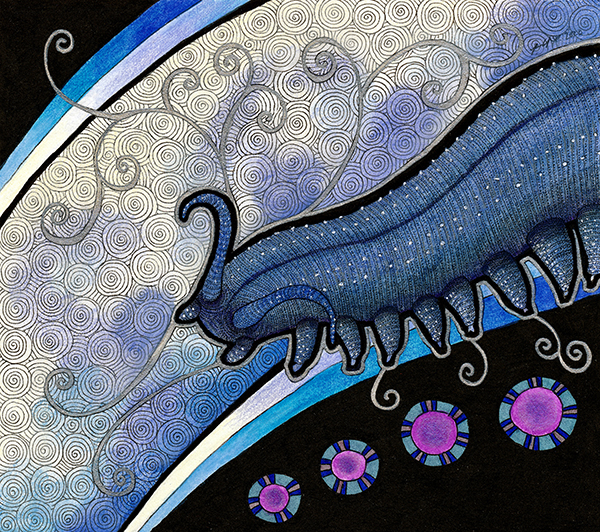Velvet Worm – The Ancient Hunter
(Pictured: the Tallaganda Velvet Worm, or Euperipatoides rowelli)
Keywords:
The ancient hunter. Entanglement. Dominance and submission. Drying out. The wanderer. A complex relationship with water. Fluid and flow. Steady as she goes. Nothing needs to change. Unchanging. Perfect as you are. Secretive. Hiding from the light. Shadows have great yields. The benefits of shadow work. Look to the dark. Avid and hungry for more. Complex social interactions. Where do you stand among your friends? Establishing rank. Night secrets. Not everything needs to be revealed right now. Using what works well for you. Do you really need anything new?
Description:
The velvet worms belong to the Onychophora family, and are known as onychophorans (meaning claw bearers). They are small (2-10 centimetres in length), nocturnal, terrestrial worms that superficially resemble caterpillars. They are usually blue-grey or brown (though white cave species have been reported) and often beautifully, intricately patterned. Their velvet-like appearance is caused by rows of small, overlapping scales that are moulted regularly, their skin repels water and is covered in hairs that are sensitive to touch and smell. They have antennae and clawed, stumpy legs, and move via fluid pressure which gives them flowing form and a stealthy, silent movement. Their body structure has remained relatively unchanged for around 500 million years. They are secretive, cryptic and photonegative, meaning they actively hide from the light.
They can be found in widely diverse habitats, on nearly every continent except for Antarctica, from alpine to tropical regions. Australia has the largest number and greatest diversity of velvet worms, with some 70~ species. However they all require high humidity environments, so are found in moist areas like rotting logs and leaf litter. Increasingly, their habitats are disturbed by humans. A couple of hundred species are known, with more likely to be found. Some are critically endangered due to habitat destruction, climate change, and the pet trade. Velvet worms are highly effective, active carnivores that actively hunt and feed on other small invertebrates by squirting a sticky slime from their mouths (also used as a defence mechanism) to trap their prey. The entangled prey is then eaten with the help of digestive saliva. They eat their own slime whenever they can, as it takes 24 days to replace an exhausted supply.
Unusually, they are capable of surprisingly sophisticated social interactions from genus to genus. They can sometimes live together, show affiliation with velvet worms they live with and aggression towards those they don’t, and can even display dominant and submissive behaviours among a ranking system. Males and females will establish social pairs, along with males and males, and females and females. Unrelated females are often very aggressive towards each other.
Was this helpful?
0 / 0